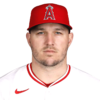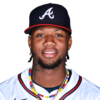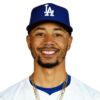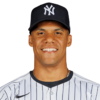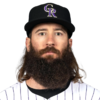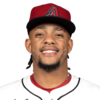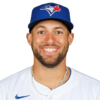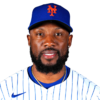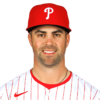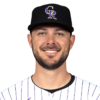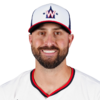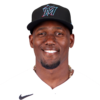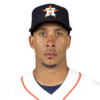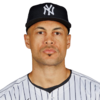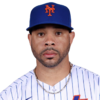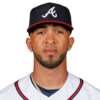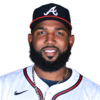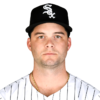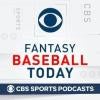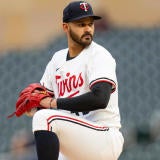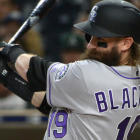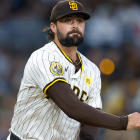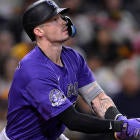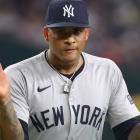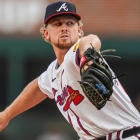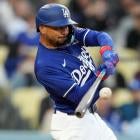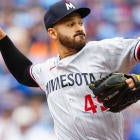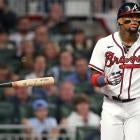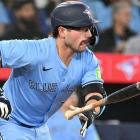We're in it now. Outfield ... that's one of the big ones.
Going 20 deep around the infield I thought provided a mostly complete picture of each position, at least in the context of a shallower mixed league. But there are three times as many of these guys. So ... what, you want 60 of them? Let's leave the October heroics to the professionals.
I have my top 30 here, and it gets pretty murky after that. Organizing guys like Nicholas Castellanos, David Dahl, Mark Canha, Willie Calhoun, Nick Senzel and Oscar Mercado into some sensible rank list will not be an enviable task, let me tell you.
But it's tomorrow's problem. These 30 I feel pretty good about. I would have liked to get Yasiel Puig in there, too, but clearly you can see there's no shortage of promising options for three-outfielder leagues.
And this position just so happens to offer what figure to be the first five picks of most every draft.
| 1 |
Mike Trout
Los Angeles Angels CF
|
| Whether it's Paul Goldschmidt, Bryce Harper, Jose Altuve, or, most recently, Mookie Betts, anytime anyone has made a case to go No. 1 overall, ahead of Mike Trout, it's only led to regrets. Trout has his competitors every year, but he's the only one in the discussion year after year, making him a foolproof choice as the top overall pick. | |
| 2 |
Christian Yelich
Milwaukee Brewers RF
|
| The latest contender to the top overall spot has hung with Trout for two years and, against all odds, improved on his MVP-winning 2018 by increasing his launch angle while retaining an other-worldly home run-to-fly ball rate. And with Christian Yelich also emerging as a more prolific base-stealer than Trout, he would have had a compelling case to go ahead of him if a fractured kneecap late in the year hadn't thrown that particular skill into doubt. | |
| 3 |
Ronald Acuna
Atlanta Braves CF
|
| There will be trend-setters who make Ronald Acuna the top overall pick, if only in traditional 5x5 leagues where stolen bases are in such high demand. But hey, as long as he hits in the leadoff spot, he's going to run -- that particular trend has played out two years in a row now -- and he'll run more than anyone else with a first round-caliber bat. He's not the complete hitter Trout and Yelich are, but seeing as he'll be 22 next year, he should only get better. | |
| 4 |
Cody Bellinger
Los Angeles Dodgers RF
|
| Though Cody Bellinger finished with MVP-caliber numbers, his first two months were markedly better than his final four months. But his most notable skill change, a greatly improved strikeout rate, more or less maintained, which, along with his high xBA, suggests that the full-season numbers are more indicative than any partial-season ones. He's not just fourth here, but fourth overall. | |
| 5 |
Mookie Betts
Boston Red Sox RF
|
| Mookie Betts couldn't quite measure up to his Trout-like performance from a year earlier, but a strong finish left no doubt he's still among the game's super elite and worthy of a top-five pick in all formats. He trails the top four in home run potential, and the steals have been up and down. But the contact and on-base skills stand out, making him a safe bet for batting average and a big run total. | |
| 6 |
J.D. Martinez
Boston Red Sox DH
|
| J.D. Martinez took a step back from his previous two seasons, which is a little worrisome since he's now 32, but the batted-ball profile suggests the skills aren't waning. Move him down a round, from the first to the second, and you'll make out nicely. | |
| 7 |
Juan Soto
Washington Nationals LF
|
| If there was a concern to take away from Juan Soto's historic age-19 season, it was that he might put the ball on the ground too much to sustain that level of power production. So he stopped putting the ball on the ground so much in his age-20 season, and now it's pretty clear the direction he's headed. His bat skills are off the charts for a player so young, and particularly in leagues that will reward his on-base ability, he's worthy of this ranking even without the expected improvement. | |
| 8 |
Charlie Blackmon
Colorado Rockies RF
|
| It's pretty wild that early mock drafts have shown Charlie Blackmon going as late as Round 4 even though he reversed whatever discouraging trends had begun to show in 2018. Maybe the decline begins at age 33, or maybe the Rockies fall out of the race early and shop him. But if he stays in Colorado and stays healthy, he's a near lock for a .300 average, 30 homers and 110 runs, which sounds like second-round material to me. | |
| 9 |
Ketel Marte
Arizona Diamondbacks CF
|
| I'll catch some flak for ranking Ketel Marte this high, so it's worth pointing out his actual production suggests he should go even higher. He made harder, more efficient contact in 2019 -- lots of it -- and while many presumed he wouldn't sustain it in the second half, he only got better. Maybe it was all smoke in mirrors, but the underlying numbers suggest otherwise. And the most useful kind of dual-eligibility may well be the kind he has: second base and the outfield. | |
| 10 |
Aaron Judge
New York Yankees RF
|
| There will be others who give Aaron Judge more benefit of the doubt. He still makes the sort of crazy-hard contact needed to overcome a disastrous strikeout rate. He still takes a ton of free passes and is a perennial candidate for 50 homers. But in back to back years now, he has only gotten halfway there because of an inability to stay on the field. It's not a full-blown pattern yet, but his massive size works against him in that regard. | |
| 11 |
George Springer
Houston Astros CF
|
| The 2019 version of George Springer was about as good as anyone could expect Judge to be, which makes the choice between them nearly a toss-up for me. But that level of production was new for Springer, who had often fallen short of expectations previously, and the only discernible skill change was a harder contact rate. Maybe it's sustainable, but seeing as he has a tendency to get banged up, too, I'll give the edge to Judge. | |
| 12 |
Starling Marte
Pittsburgh Pirates CF
|
| With little fanfare, Starling Marte just put together a career-best season as a 30-year-old who was previously showing signs of decline. No red flags in the batted-ball profile either -- it just seems like he delivered the most optimal version of himself. That version includes a high steals total, of course -- not the highest he's ever provided, but plenty high enough to cut into the league-wide scarcity. The lack of walks holds back his points-league value, but not as much as you might think. | |
| 13 |
Whit Merrifield
Kansas City Royals 2B
|
| As an elite line-drive hitter who can occasionally put one over the fence, Whit Merrifield offers a diverse enough skill set that the decline of his MLB-leading steals total by more than one-half wasn't a disaster for his 2019 value. But it wasn't good. People who draft him want steals first and foremost, and because he got thrown out on about one-third of his attempts, there's no guarantee he gets back to being a 40-steal guy. | |
| 14 |
Kris Bryant
Chicago Cubs 3B
|
| Though he's also eligible at third base, you'd be more likely to play Kris Bryant here, and it's easier to justify an early-round pick on him considering. But even though he got back to the 30-homer threshold in 2019, it's now three years of his power not quite being at the level he showed during his 2016 MVP season. And particularly in leagues that don't reward his on-base skills, the power is mostly driving his value. He's still great, but maybe less than elite. | |
| 15 |
Bryce Harper
Philadelphia Phillies RF
|
| I swore I wouldn't again fall victim to the usual pie-in-the-sky hopes for Bryce Harper after his 2019 began so miserably, and this ranking obviously ensures he won't be a first- or second-rounder again. But it's worth pointing out he got better as the season played out, most notably by reining in his run-amok strikeout rate, which offers some hope of him being some help in batting average again someday. The more realistic expectation, though, is that he's a speedier Max Muncy. | |
| 16 |
Joey Gallo
Texas Rangers CF
|
| Joey Gallo may have improved his expected batting line in 2019 ... or he may not have. The official xBA says no, in large part because his already horrendous strikeout rate got even worse. But a greatly improved line-drive rate elevated his BABIP to a level that's not so far-fetched given how hard he hits the ball, and it led to a respectable enough batting average. There's a chance, then, he's as good as Aaron Judge, but particularly with his season being cut short by injury, I'd like to see more. | |
| 17 |
Austin Meadows
Tampa Bay Rays RF
|
| Though there were extreme highs and lows in his first full big-league season, Austin Meadows ended on a high enough note to earn high marks from me, especially since his fly-ball and hard-hit rates more or less backed up the most unexpected of his contributions, the home run power. He also has reasonably good plate discipline and isn't a zero for stolen bases. | |
| 18 |
Jorge Soler
Kansas City Royals DH
|
| After offering some small reminders of his potential during an injury-shortened 2018, Jorge Soler finally exploded with monster power numbers in his sixth big-league season. And it just kept getting better and better, his strikeout and line-drive rates improving so much in the second half that batting average may actually be a strength for him now rather than a liability. I'll tend toward caution given all it took to get him here, but this ranking may be underselling him. | |
| 19 |
Michael Brantley
Houston Astros LF
|
| Two consecutive years of good health may give us a false sense of security for a guy who'll be turning 33 next year, but when healthy, Michael Brantley is so bankable for batting average and makes such consistent contact that he's a uniquely desirable player in both categories and points leagues. Batting in the Astros lineup pads out his stats nicely, too. | |
| 20 |
Jeff McNeil
New York Mets 2B
|
| Also eligible at second and third base (where I rank him eighth and 10th, respectively), Jeff McNeil is a handy player whose expected batting line looks a lot like Brantley's, especially if you buy into his second-half power breakthrough (which I do). His capacity to hit .300 shouldn't be in question given ability to put bat on ball. | |
| 21 |
Giancarlo Stanton
New York Yankees LF
|
| Though he's Fantasy royalty, Giancarlo Stanton is far from a known quantity heading into 2020. After his MVP-winning 2017, there was a notable skills decline in 2018, and since he then lost almost all of 2019 to injury, it's hard to say where he stands going into his age-30 season. He'll presumably hit a lot of home runs, provided he can stay on the field, and batting in the Yankees lineups will make up for his shortcomings. But is he a liability in batting average now? | |
| 22 |
Tommy Pham
Tampa Bay Rays LF
|
| Injury risk should be factored into the cost for Tommy Pham as well, especially since he'll be 32 next year, but the fact he's been a 20-steal guy two of the past three years could be justification to move him up a few spots in traditional 5x5 leagues. It's just that he puts the ball on the ground so much that you have to expect the power numbers to continue trending down. And if his strikeout rate reverts back to previous norms, where does it leave his batting average? | |
| 23 |
Max Kepler
Minnesota Twins RF
|
| A perplexing player in so many ways, Max Kepler finally had the big power breakthrough that he seemed to be trending toward, but he ended up selling out so hard for power, particularly in the second half, that his average on balls in play was pretty disgusting. As little as he strikes out, you'd think there's more batting average potential there, but he appears to have made his choice as to what kind of hitter he wants to be. | |
| 24 |
Eddie Rosario
Minnesota Twins LF
|
| Eddie Rosario's power production in 2019 went a little beyond what we're used to seeing from him, leading to a second-half correction, but on the other hand, he's usually a better source of batting average given how little he strikes out. The batted-ball profile was largely unchanged from one year to the next, so our approach to him should remain about the same, too. | |
| 25 |
Trey Mancini
Baltimore Orioles RF
|
| Checking in at 14th in my first base rankings, Trey Mancini did a better job of elevating the ball this year while making much more consistent contact. In fact, the plate discipline as a whole improved, shoring up one area of weakness. The big increases in batting average and home runs were both pretty believable, then, and I trust him to be a solid contributor in both even if his supporting cast holds him back. | |
| 26 |
Michael Conforto
New York Mets RF
|
| Michael Conforto was finally healthy enough from start to finish to deliver the big home run season so many thought he could have, but it wasn't enough to make him a Fantasy stud. Does he have more upside from here, or is he limited to be a .260-hitting, 30-homer type? It's not a bad thing to be, especially when it's elevated by plus on-base skills, but we've arrived at a crowded stretch in the rankings wherein upside is paramount. | |
| 27 |
Marcell Ozuna
St. Louis Cardinals LF
|
| A fractured finger in late June wrecked what was shaping up to be an impressive resurgence for Marcell Ozuna, but the demise was mostly a case of tough luck. The differences between his xwOBA and actual wOBA and his xBA and actual batting average were among the largest for any hitter. Wherever he lands this offseason, you should expect better things. | |
| 28 |
Eloy Jimenez
Chicago White Sox LF
|
| You know how I said upside is paramount within this stretch of the rankings? Well, we know Eloy Jimenez has bunches of it, and after squandering much of his rookie season, he finally put it to good use over the final month, putting him across the 30-homer threshold. In fact, the final line ended up being about what anybody could have reasonably hoped for. His plate discipline needs work, but Jimenez showed something to build on. | |
| 29 | 
Ramon Laureano
Oakland Athletics CF
|
| Ramon Laureano plays a little better in categories leagues than points leagues since the plate discipline is lacking and the steals are part of what you're paying for, but if he's the guy we saw in the month before and after the shin injury that sidelined him in August, he'll be must-start everywhere. His five-category potential depends on him having a high BABIP, but he may just have the batted-ball profile to pull it off. | |
| 30 |
Andrew Benintendi
Boston Red Sox LF
|
| I guess we're doing this still, even though with each passing year Andrew Benintendi begins to resemble Nick Markakis all the more. He's a former No. 1 overall prospect and is only 25, so there's still a chance for a Rafael Devers-level breakthrough. Past enthusiasm counted on him improving, though, and instead, his power numbers have gone down while the rest of the league's has gone up. He's no longer a surefire base-stealer, and he's started striking out more, too. | |







